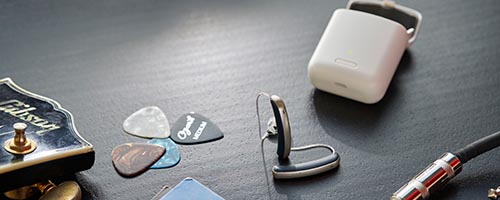Selecting The Right Hearing Aid
How We Help Find The best Best Solution For You
There are four primary steps that must be made when selecting a hearing aid. The hearing test is always the best place to start. Based on the test results, and a conversation to determine information about your specific wants, needs and lifestyle, we can then help guide you through choosing the style of the case that the hearing aid circuitry will be housed in, the performance level of the hearing aid, and finally, the manufacturer of the hearing aid. Our years of experience will ensure that you get the hearing aids that best suit all of your individual needs.
1. Have Your Hearing Tested
Having your hearing tested is always the best place to start the process of getting new hearing aids. This will provide your hearing healthcare professional with a thorough understanding of the impact that your specific hearing loss would present in day-to-day environments.
After your test, we will explain the results in plain, easy-to-understand language. If there is a hearing test, we will then provide you with the necessary information and guide you through steps 2-4, which include the selection of the style of hearing aid, level of performance and the manufacturer able to meet your unique hearing needs.
As a family centred company, we recommend bringing someone close to you to your appointment. Be it a family member or close friend. They will be able to offer another perspective of how you are hearing in day-to-day environments and support you in making any decisions to do with any hearing loss – a second set of ears is always helpful!
2. Choose the Hearing Aid Style You Want
When choosing a style of hearing aid there are several factors to consider. First is the degree and nature of the hearing loss. Second is the need to match the power to the style of hearing aid. Cosmetic appeal and manual dexterity are also important considerations when choosing a hearing aid. We will help you choose the appropriate style of hearing aid to suit your individual needs.
RIC
Receiver in the Canal
RIC
RIC hearing aids are the ideal solution for most first time hearing aid users with mild to moderate high frequency hearing loss. Their nearly invisible open design offers unmatched comfort and a very natural sound.
ITC
In the Canal
ITC
ITC hearing aids are slightly visible and are best suited for mild to severe hearing losses. ITC hearing aids typically include directional microphones, which provides better hearing in noise.
Lyric
Extended Wear
Extended Wear
Extended wear offers unmatched simplicity for those with mild to moderate hearing loss. They are a completely invisible product, with no batteries to change and no daily insertion.
IIC & CIC
Completely in the Canal
IIC & CIC
These are the smallest style and are nearly invisible. They are best suited for mild to moderate hearing losses. Due to their small size, they require good dexterity and have a shorter battery life than some of the larger models.
ITE
In the Ear
ITE
ITE hearing aids have the same fitting range and options as the ITC models, but in a slightly larger design making them easier to insert and remove. They also have a larger battery size offering the longest battery life, while making it easier to change batteries.
BTE
Behind the Ear
BTE
BTE hearing aids tend to be the most powerful models. For anyone with a very severe to profound hearing loss, this style is still the best option. They offer directional microphones for improved hearing in background noise and built in volume and program controls.
3. Choose the Treatment Plan You Need
Now that we have the style, it’s time to choose between Good, Better and Best performance. The price you pay for a hearing aid can range from $495 to over $3000 per aid. While this is an extremely wide range, it is important to understand that there are significant differences between the hearing aids at the various price levels. As consumers, we all want to get the best products and services at a price we can afford.
How is a more expensive hearing aid different than a less expensive one?
The price you pay is a reflection of the hearing aid’s sound quality and performance. As a rule, the more you pay, the better the product will work in more challenging listening environments, such as in groups, churches or halls, and other loud places where there is background noise.
Are smaller hearing aids more expensive?
Not necessarily. The price of a hearing aid has little to do with the appearance. You can purchase most styles of hearing aids in any price range. Also, the price is not associated with how powerful a hearing aid is and has very little to do with the brand.
Will I have to pay more for extra hearing aid features?
In general, your hearing aids can be set up any way you want without affecting the price. Want a volume control or a program button? It won’t cost you any more. Most models even offer a remote control for volume and program changes at no additional cost.
Satisfaction vs. Performance Level
A recent study looked at overall user satisfaction with their hearing aids compared to which performance level they were using. The results strongly support the fact that in challenging listening environments, as you increase in performance, the separation of speech from noise is enhanced, and overall sound quality is improved.
%
Good - 5.8/10
%
Better - 7.3/10
%
Best - 8.7/10
4. Choose the Hearing Aid Manufacturer With the Right Features
How Our Independence Benefits You
Our ability to deal with all manufacturers means that we will help you choose the BEST product for YOU! Unlike an ever growing number of our competitors which are owned by manufacturers, Davidson’s remains a family owned business, which allows us to choose from all manufacturers’ makes and models. Although it is true that all of the major hearing aid manufacturers now make very good hearing aids, there are significant differences in sound quality, programs, design and connectivity, which means that the brand which is best for one person may not be the best for the next. Our independence and relationships with all of the major hearing aid manufactures provides us the flexibility to prescribe the best possible products to meet our patient’s individual hearing needs. Our years of experience will ensure that you get the hearing aids that best suit all of your needs. We have access to all manufacturers sold in Canada and can repair any of these makes of hearing aids.
Although we carry hundreds of different models of hearing aids, and always suggest consulting with our hearing health care professionals before making a final decision, we have tried to put together some key information highlighting the most recent features and accessories from each of the main manufacturers that we work with on a day-to-day basis. Please click on the links below to view these hearing aid products.
Our primary hearing aid suppliers:
(Click a logo to see more product information)










Additional companies that we work with and support:






Request a Callback
Whether you’re concerned about your hearing or a loved one’s hearing, it can be an overwhelming and confusing position to find yourself in. With so much conflicting and contradictory information available online, it can be confusing to know who to trust.
The good news is that we’re here to help.
If you have a question or would like some no-obligation professional advice, then simply complete this form and a member of our team will call you to answer your questions and offer you friendly support.
Remember, there’s no such thing as a silly question!
Have Questions About Hearing Loss?
Our Hearing Aid Guide was created to help you understand the implications of hearing loss and what is involved in choosing the right hearing aids. It will provide you with background information and prompt you to ask the right questions before making a final decision. Hopefully this guide helps you on your journey towards improved hearing.



